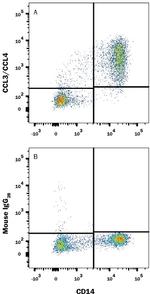Search Thermo Fisher Scientific
Invitrogen
CCL3 Monoclonal Antibody (93342), FITC
FIGURE: 1 / 1
CCL3 Antibody (MA5-23564) in Flow

Product Details
MA5-23564
Species Reactivity
Published species
Host/Isotype
Class
Type
Clone
Immunogen
Conjugate
Excitation/Emission Max
Form
Purification
Storage buffer
Contains
Storage conditions
Shipping conditions
RRID
Target Information
Both MIP-1alpha and MIP-1beta are structurally and functionally related CC chemokines. They participate in host response to invading bacterial, viral, parasite and fungal pathogens by regulating the trafficking and activation state of selected subgroups of inflammatory cells (e.g. macrophages, lymphocytes and NK cells). While both MIP-1alpha and MIP-1beta exert similar effects on monocytes, their effect on lymphocytes differ; with MIP-1alpha selectively attracting CD8+ lymphocytes, and MIP-1beta selectively attracting CD4+ lymphocytes. Additionally, MIP-1alpha and MIP-1beta have also been shown to be potent chemoattractants for B cells, eosinophils and dendritic cells. Both human and murine MIP-1alpha and MIP-1beta are active on human and murine hematopoietic cells.
For Research Use Only. Not for use in diagnostic procedures. Not for resale without express authorization.
How to use the Panel Builder
Watch the video to learn how to use the Invitrogen Flow Cytometry Panel Builder to build your next flow cytometry panel in 5 easy steps.
Bioinformatics
Protein Aliases: C-C motif chemokine 3; chemokine (C-C motif) ligand 3; G0/G1 switch regulatory protein 19-1; H-MIP-1-alpha; LD78-alpha; Macrophage inflammatory protein 1-alpha; MIP-1-alpha; mip1 alpha; PAT 464.1; RP23-320E6.7; SIS-beta; small inducible cytokine A3 (homologous to mouse Mip-1a); Small-inducible cytokine A3; Tonsillar lymphocyte LD78 alpha protein
Gene Aliases: CCL3; G0S19-1; LD78ALPHA; MIP-1-alpha; MIP1A; SCYA3
UniProt ID: (Human) P10147
Entrez Gene ID: (Human) 6348

Performance Guarantee
If an Invitrogen™ antibody doesn't perform as described on our website or datasheet,we'll replace the product at no cost to you, or provide you with a credit for a future purchase.*
Learn more
We're here to help
Get expert recommendations for common problems or connect directly with an on staff expert for technical assistance related to applications, equipment and general product use.
Contact tech support

